Lesson 2: Creating a Blank Presentation
/en/powerpointxp/the-powerpoint-window/content/
Introduction
By the end of this lesson, you should be able to:
- Choose and apply a slide layout
- Add text to a placeholder
- Save and close a presentation
- Exit PowerPoint
Creating a blank presentation
PowerPoint offers three ways to create a presentation: Blank presentation, From Design Template, and From AutoContent Wizard.
The blank presentation option is one of the more commonly used methods. It offers several blank slides with layouts for text and graphics.
To create a blank presentation:
- Open PowerPoint.
- A slide featuring a place for a title and subtitle appears by default. You can begin your presentation with this slide or choose a different slide layout.
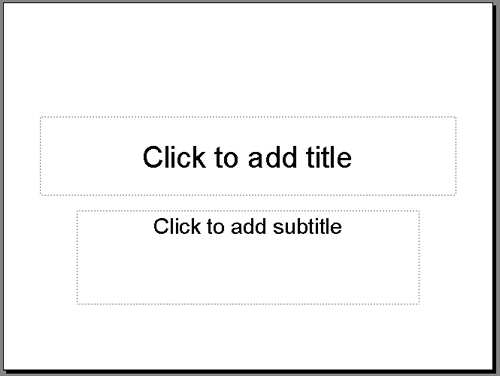
- The New Presentation Pane appears on the right side of the screen.
- Under New, click Blank Presentation.
- A list appears.
Choosing a slide layout
As you work on your presentation, think about the type of layout you want. Do you want a slide with text and a lot of clip art or one with text and a chart? PowerPoint offers several layout options.
To choose a slide layout:
- Move your arrow pointer over the layouts or use the scroll bar in the Slide Layout pane.
- A gray bar appears on the right of each layout.
- When you find a layout you like, click the down-pointing arrow and choose Apply to Selected Slide.
 You can also click the slide layout to apply it. Notice that the slide you are currently working on has a dark border in the Outline pane.
You can also click the slide layout to apply it. Notice that the slide you are currently working on has a dark border in the Outline pane.
Placeholders
Once you choose a layout for your slides, you can begin adding text, graphics, and other items. You do this with placeholders—special places within a slide where you can add content.
To add text to a placeholder:
- Click the placeholder.
- Start typing.

You'll learn about inserting clip art and other graphics into placeholders later in this course.
Saving a presentation
You can save, close, and exit presentations in PowerPoint just as you would with other Microsoft applications.
To save a presentation:
- Click File
 Save (Ctrl+S).
Save (Ctrl+S).
- Choose the location where you want to save your presentation.
- Type a name in the File Name box or keep the one PowerPoint has provided.
Closing a presentation and exiting PowerPoint
Once you've finishing working on your presentation, you can quickly close it.
To close a presentation:
- Click X in the PowerPoint presentation window (Ctrl+W).
- The PowerPoint application remains open and you can start a new presentation.
To exit PowerPoint:
- Click X in the top-right corner.

OR
- Choose File
 Exit (Alt+F4).
Exit (Alt+F4).
 Before you exit PowerPoint, save any work you want to keep.
Before you exit PowerPoint, save any work you want to keep.
Creating a new presentation using the traditional method
Remember, after you have closed one presentation, you can easily start a new one while PowerPoint is still open by using the traditional new file creation method.
To start a new presentation:
- Click File
 New (Ctrl+N).
New (Ctrl+N).
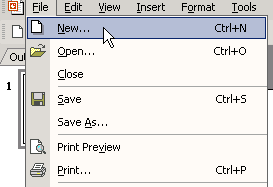
- In the New Presentation pane, under New choose Blank Presentation.
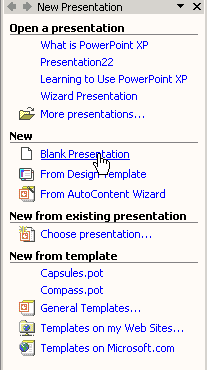
- Choose the design layout you want.
 Remember, if your task pane disappears from the right side of the screen, click View
Remember, if your task pane disappears from the right side of the screen, click View Task Pane.
Task Pane.
Challenge!
- Start PowerPoint.
- Choose a slide layout with a title placeholder only.
- Type the following as the title: Learning to Use PowerPoint XP.
- Familiarize yourself with the task pane on the right side of the screen. Click the down-pointing arrow in the top-right corner of the pane.
- Return to the New Presentation pane.
- Close your PowerPoint slide and save it as Learning to Use PowerPoint XP.
- Exit PowerPoint.
/en/powerpointxp/inserting-copying-and-deleting-slides/content/



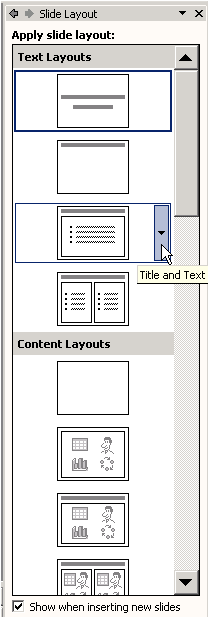
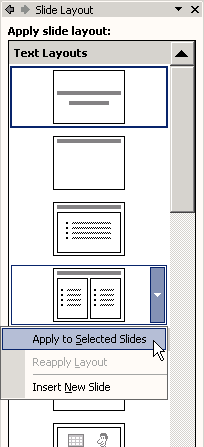
 You can also click the slide layout to apply it. Notice that the slide you are currently working on has a dark border in the Outline pane.
You can also click the slide layout to apply it. Notice that the slide you are currently working on has a dark border in the Outline pane.
 Save (Ctrl+S).
Save (Ctrl+S).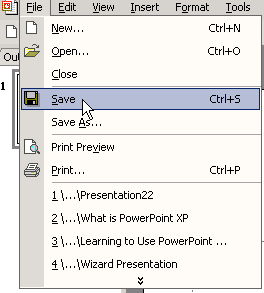


 Exit (Alt+F4).
Exit (Alt+F4). Before you exit PowerPoint, save any work you want to keep.
Before you exit PowerPoint, save any work you want to keep. New (Ctrl+N).
New (Ctrl+N).

 Remember, if your task pane disappears from the right side of the screen, click View
Remember, if your task pane disappears from the right side of the screen, click View Task Pane.
Task Pane.